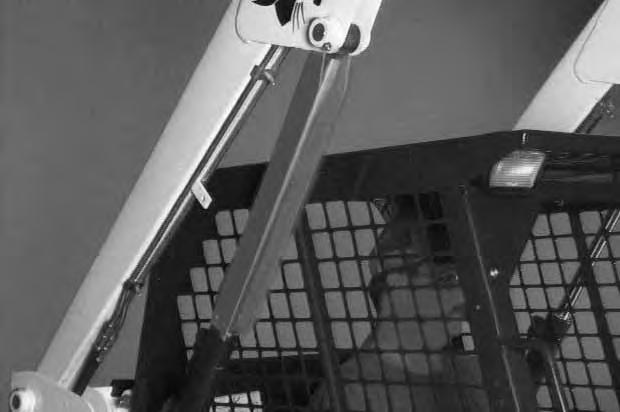
9 minute read
MAINTENANCE SAFETY
Instructions are necessary before operating or servicing machine. Read Operation & Maintenance Manual, Handbook and signs (decals) on machine. Follow warnings and instructions in the manuals when making repairs, adjustments or servicing. Check for correct function after adjustments, repairs or service. Failure to follow instructions can cause injury or death.
Safety Alert Symbol:This symbol with a warning statement, means: “Warning, be alert! Your safety is involved!” Carefully read the message that follows.
Correct
Correct
Correct
Never service the Bobcat® Skid Steer Loader without instructions.
Wrong
Use the correct procedure to lift or lower operator cab with lift arms down.
Cleaning and maintenance are required daily.
Wrong Wrong
Have good ventilation when welding or grinding painted parts. Wear dust mask when grinding painted parts. Toxic dust and gas can be produced.
Wrong
Stop, cool and clean engine of flammable materials before checking fluids.
Never service or adjust loader with the engine running unless instructed to do so in the manual. Avoid contact with leaking hydraulic fluid or diesel fuel under pressure. It can penetrate the skin or eyes.
Never fill fuel tank with engine running, while smoking or when near open flame.
Vent exhaust to outside when engine must be run for service. Avoid exhaust fume leaks which can kill without warning. Exhaust system must be tightly sealed.
Never work on loader with lift arms up unless lift arms are held by an approved lift arm support device. Replace if damaged. Never modify equipment or add attachments not approved by Melroe Company.
Wrong Wrong
Keep body, jewelry and clothing away from moving parts, electrical contacts, hot parts and exhaust.
Wear eye protection to guard from battery acid, compressed springs, fluids under pressure and flying debris when engines are running or tools are used. Use eye protection approved for type of welding. Keep rear door closed except for service. Close and latch door before operating the loader.
Lead–acid batteries produce flammable and explosive gases. Keep arcs, sparks, flames and lighted tobacco away from batteries. Batteries contain acid which burns eyes or skin on contact. Wear protective clothing. If acid contacts body, flush well with water. For eye contact flush well and get immediate medical attention.
Maintenance procedures which are given in the Operation & Maintenance Manual can be performed by the owner/operator without any specific technical training. Maintenance procedures which arenot in the Operation & Maintenance Manual must be performed ONLY BY QUALIFIED BOBCAT SERVICE PERSONNEL. Always use genuine Bobcat replacement parts.
Service Schedule
Maintenance work must be done at regular intervals. Failure to do so will result in excessivewear and early failures. The service schedule is a guide for correct maintenance of the Bobcat loader.
Instructions are necessary before operating or servicing machine. Read Operation & Maintenance Manual, Handbook and signs (decals) on machine. Follow warnings and instructions in the manuals when making repairs, adjustments or servicing. Check for correct function after adjustments, repairs or service. Failure to follow instructions can cause injury or death.
Engine Oil
Check the oil level and add oil as needed.
Engine Air Filter Replace the outer filter element only when the red ring shows in the and Air System indicator window. Check for leaks and damaged components.
Engine Cooling SystemClean debris from oil cooler, radiator & grill. Check coolant level in recovery tank and add as needed.
Tires Check for damaged tires and correct air pressure.
Seat Belt and Seat Bar and Check the condition of seat belt. Check the seat bar & pedal inter–Control Interlocks locks for correct operation. Clean dirt & debris from moving parts.
Safety Signs and SafetyCheck for damaged signs (decals) and safetytreads. Replace any Tread signs or safety treads that are damaged or worn.
Indicator & Lights (Opt.)Check for correct operation of all indicators & lights.
Operator Cab Check the fastening bolts, washers & nuts. Check the conditionof cab.
Lift Arm and Bob–TachLubricate with multi–purpose lithium based grease.
Pivot Pin and Wedges
Engine Fuel Filter Remove the trapped water.
Bobcat Interlock ControlCheck BICS™ System Controller functions. Clean dirt, debris or System (BICSTM) objects from under or behind seat as required.
Hyd. Fluid, Hoses & Check fluid level & add as needed. Check for damage & leaks.
Tubelines Repair & replace as needed.
Control Pedals & SteeringCheck for correct operation. Repair or adjust as needed.
Wheel Nuts Check for loose wheel nuts & tighten to 105–115 ft.–lbs. (142–156Nm) torque.
Parking Brake Check operation of the brake.
Alternator Belt Check tension & adjust as needed.
Final Drive Trans. Check fluid level and add as needed. (Chaincase)
Spark Arrestor MufflerClean the spark chamber.
Battery Check cables, connections & electrolyte level. Add distilled water as needed.
Engine Oil & Filter
Replace oil & filter. Use CD or better grade oil and Melroe filter.
Fuel Filter Replace filter element.
Steering Lever PivotsGrease two fittings. Add oil to steering shaft.
U Joint Grease three (3) fittings with correct grease.
Hyd./Hydros Filter Replace the filter element.
Hyd Reservoir Breather CapReplace the reservoir breather cap.
Hyd./Hydro. ReservoirReplace the hydraulic/hydrostatic fluid.
Chaincase Replace the fluid.
Bobcat Interlock ControlCheck the lift arm by–pass control System (BICS™)
Check wheel nut torque every 8 hours for the first 24 hours.
• Also replace hydraulic/hydrostatic filter element when the transmission warning light stays on for five minutes after the fluid is at operating temperature. Or every 12 months.
Never work on a machine with the lift arms up unless the lift arms are secured by a lift arm support device. Failure to use an approved lift arm support device can allow the lift arms or attachment to fall and cause injury or death.
W–2059–0991
Engaging The Lift Arm Support Device
Maintenance and service work can be done with the lift arms lowered. If the lift arms are raised for service, use the following procedure:
Put jackstands under the rear corners of the loader frame. Remove any attachment before raising the lift arms. Disconnect the spring from the lift arm support device retaining pin (Item 1) [A]. Hold onto the lift arm support device (Item 2) [A] and remove the retaining pin.
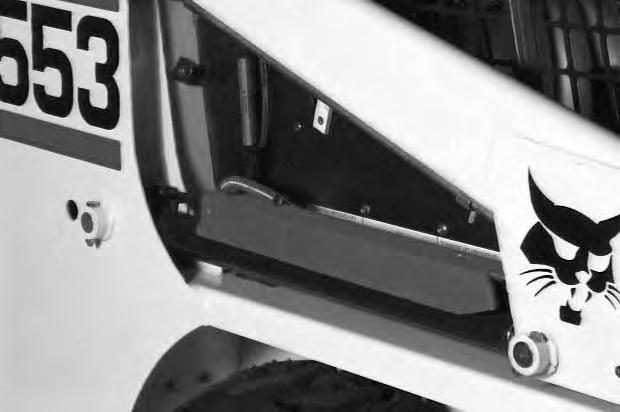
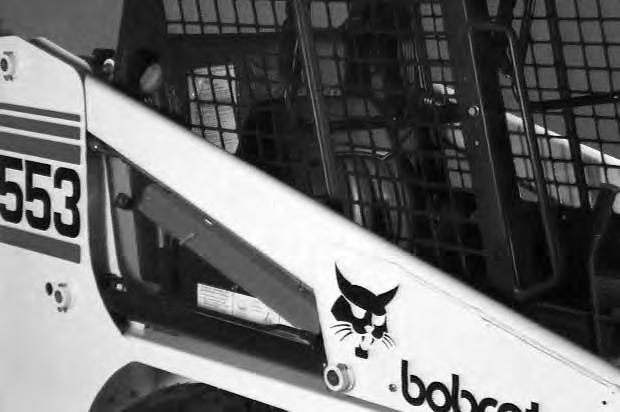
Lower the lift arm support device on top of the lift cylinder. Hook the free end of the spring (Item 1)[B] to the lift arm support device so there will be no interference with the support device engagement.
With the operator in the seat, seat belt fastened and seat bar lowered, start the engine.
Raise the lift arms, until the lift arm support device drops onto the lift cylinder rod (Item 1) [C]
Lower the lift arms slowly until the support device is held between the lift arm and the lift cylinder. Stop the engine. Raise the seat bar and move foot pedals (or hand controls) until both lock.
Service lift arm support device if damaged or if parts are missing. Using a damaged lift arm support or with missing parts can cause lift arms to drop causing injury or death.
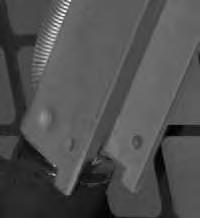
W–2271–1197
LIFT ARM SUPPORT DEVICE (Cont’d)
Engaging The Lift Arm Support Device (Cont’d)
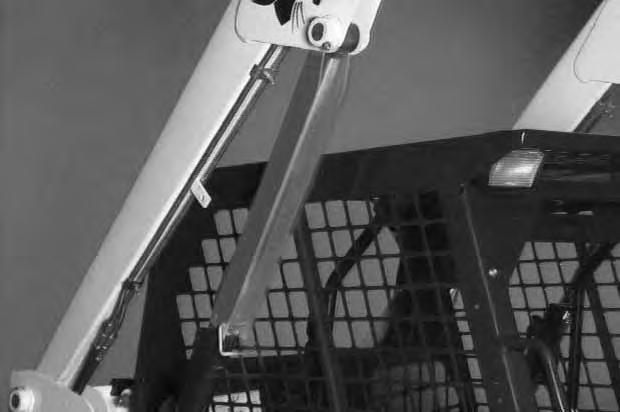
Install pin (Item 1) [A] into the rear of the lift arm support device below the cylinder rod.
Disengaging The Lift Arm Support Device
Remove the pin from the lift arm support device. Connect the spring (Item 1) [B] from the lift arm support device to the bracket below the lift arms.
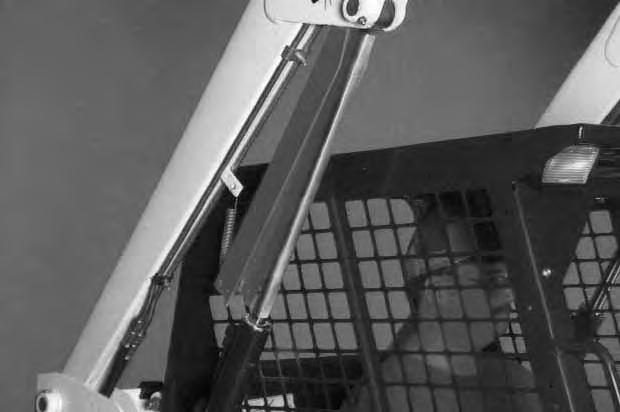
With the operator in the seat, seat belt fastened and seat bar lowered, start the engine.
Raise the lift arms a small amount and the spring will lift the support device off the lift cylinder rod.
Lower the lift arms and stop the engine.
Raise the seat bar and move pedals until both lock.

Disconnect the spring from the bracket.
Raise the support device into storage position and insert pin (Item 1) [C] through lift arm support device and bracket.
Connect spring to pin.
Operator Cab
The Bobcat loader has an operator cab (ROPS and FOPS) as standard equipment to protect the operator from rollover and falling objects. Check with your dealer if the operator cab has been damaged.
ROPS/FOPS – Roll Over Protective Structure per SAE J1040 and ISO 3471, and Falling Object Protective Structure per SAE J1043 and ISO 3449, Level I. Level II is available.
Level I – Protection from falling bricks, small concrete blocks and hand tools encountered in operations such as highway maintenance, landscaping, and other construction site services.
Level II – Protection from falling trees, rocks; for machines involved in site clearing, overhead demolition or forestry.
Never modify operator cab by welding, grinding, drilling holes or adding attachments unless instructed to do so by Melroe Company. Changes to the cab can cause loss of operator protection from rollover and falling objects, and result in injury or death.
W–2069–1285
Raising The Operator Cab
Stop the loader on a level surface. Lower the lift arms. If the lift arms must be up while raising the operator cab, install the lift arm support device. (See LIFT ARM SUPPORT DEVICE Page 30.)
Put jackstands under the rear corners of loader (Inset) [B]
Loosen the nut (both sides) at the corner of the operator cab [A].
Remove the nut and plate (both sides) [A].
Lift on the grab handle and bottom of the operator cab slowly until the cab latching mechanism engages and the cab is all the way up [B]
Lowering The Operator Cab
Pull down on the bottom of the operator cab until it stops at the latching mechanism. Release the latching mechanism [C] and pull the cab all the way down.
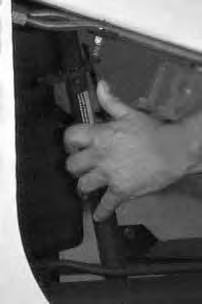
Install the plate and nut (both sides) [A]
Tighten the nuts [A] to 40–50 ft.–lbs. (54–68 Nm) torque.
Before the cab or the lift arms are raised for service, jackstands must be put under the rear corners of the frame. Failure to use jackstands may allow the machine to tip backward causing injury or death.
W–2014–1285
Both sets of fasteners at the front of the operator cab (ROPS) must be assembled as shown in this Operation & Maintenance Manual. Failure to secure ROPS correctly can cause injury or death.
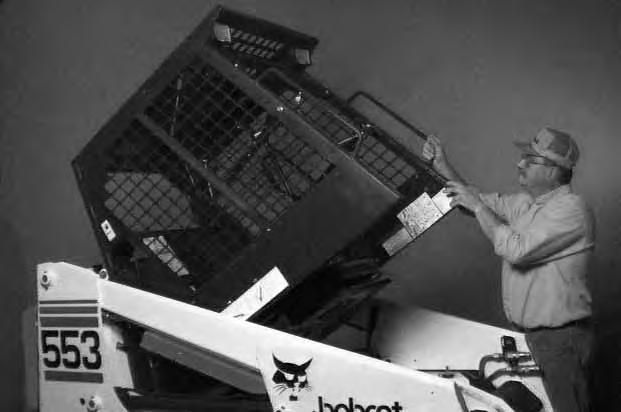
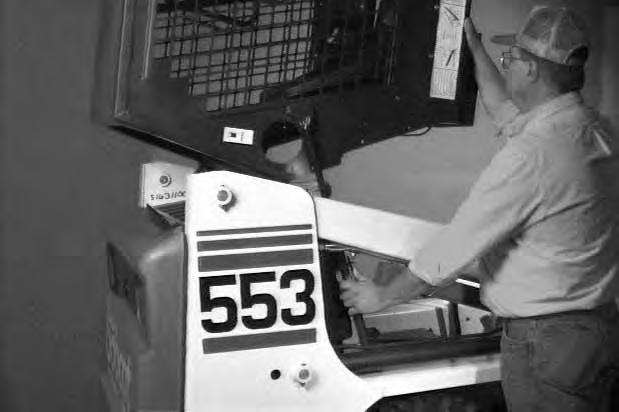
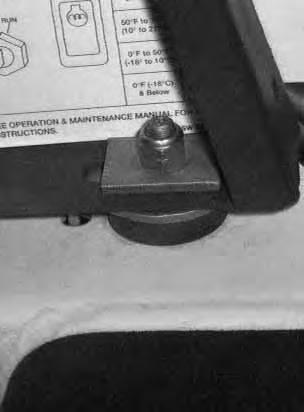
W–2005–1089
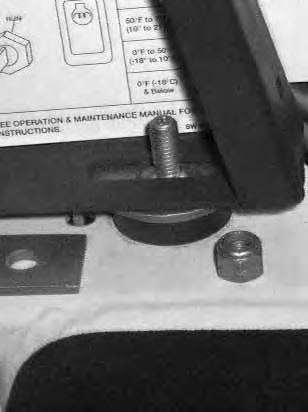
OPERATOR CAB (Cont’d)
Emergency Exits
The front opening on the operator cab and rear window provide exits.
Rear Window: (If Equipped)
• Pull on the tag on the top of the rear window to remove the rubber cord [A]
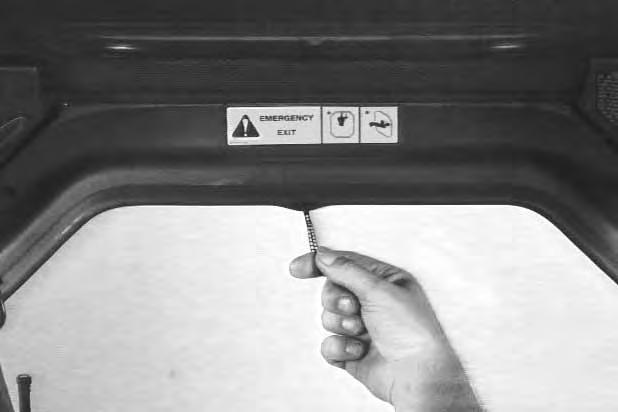

• Push the rear window out of the rear of the operator cab.
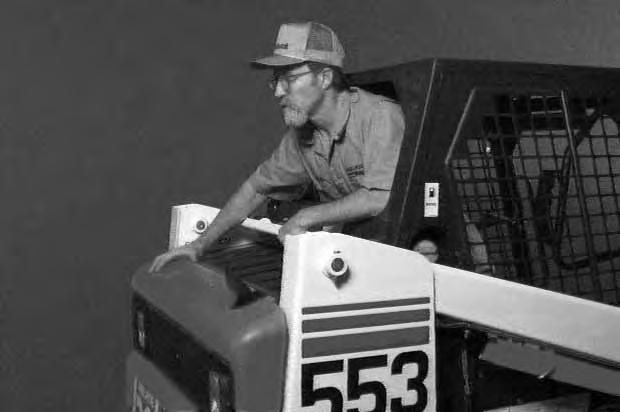
Exit through the rear of the operator cab [B]
Front Door: (If Equipped)
NOTE:When an Operator Cab Enclosure Kit is installed, the window of the front door can be used as an emergency exit. [C]
Pull the plastic loop at the top of the window in the front door to remove the rubber cord [C].
Push the window out with your foot [D].
Exit through the front door.
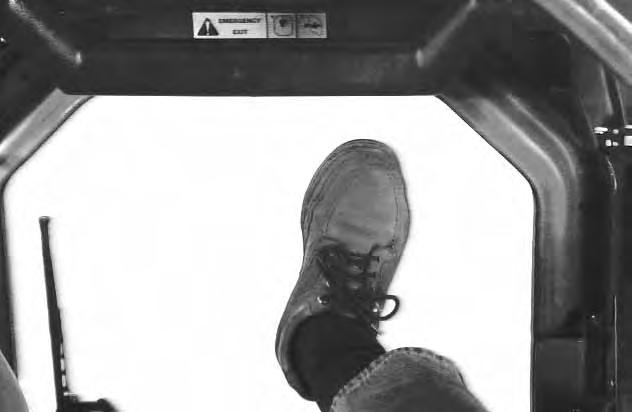
Seat Bar Restraint System
The seat bar restraint system hasa pivoting seat bar with arm rests and has spring loaded interlocks forthe lift and tilt foot pedals.
The operator controls the use of the seat bar. The seat bar in the down position helps to keep the operator in the seat.
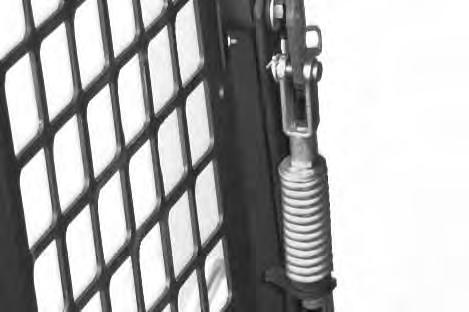
The interlocks require the operator to lower the seat bar in order to operate the foot pedal controls.
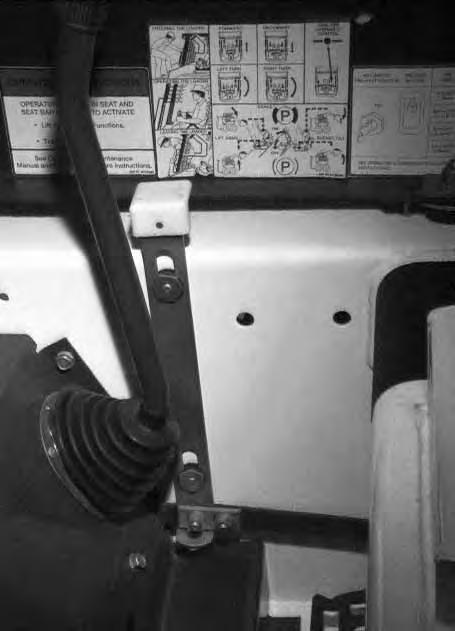
When the seat bar is up, the lift and tilt pedals are locked when returned to the NEUTRAL POSITION.
Avoid Injury Or Death
The seat bar system must lock the lift and tilt control pedals in neutral when the seat bar is up. Service the system if pedals do not lock correctly.
W–2105–1285
Inspecting The Seat Bar
Sit in the seat and fasten the seat belt. Engage the parking brake. Pull the seat bar all the way down. Start the engine.
Operate each foot pedal to check both the lift and tilt functions.
Raise the lift arms until the bucket is about 2 feet (600 mm) off the ground.
Raise the seat bar. Try to move each foot pedal. The pedals must be firmly locked in neutral position. There must be no motion of the tilt (bucket)or the lift arms when the pedals are pushed.
Pull the seat bar down. Lower the lift arms. Operate the lift pedals. While the lift arms are going up, raise theseat bar and the lift arms should stop.
Lower the seat bar, lower the lift arms and place the bucket flat on the ground. Stop the engine. Raise the seat bar and operate the foot pedals to be sure that the pedals are firmly locked in the neutral position. Unbuckle the seat belt.
Maintaining The Seat Bar
See the SERVICE SCHEDULE Page 29 and on the loader for correct service interval.
Clean any debris or dirt from the moving parts [A] & [B]
Inspect the linkage bolts and nuts for tightness. The correct torque is 25–28 ft.–lbs. (34–38 Nm).
If the seat bar system does not function correctly, check for free movement of each linkage part. Check for excessive wear. Adjust pedal control linkage. Replace parts that are worn or damaged. Use only genuine Melroe replacement parts.









